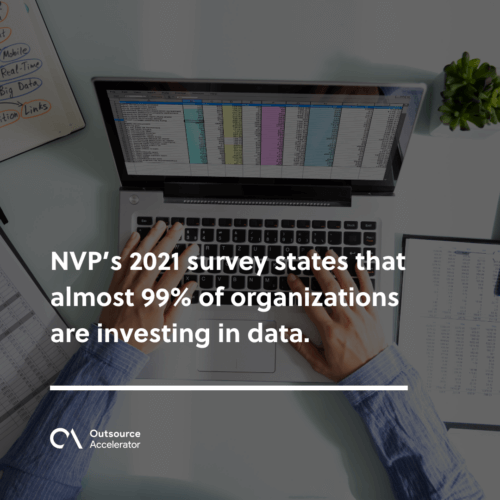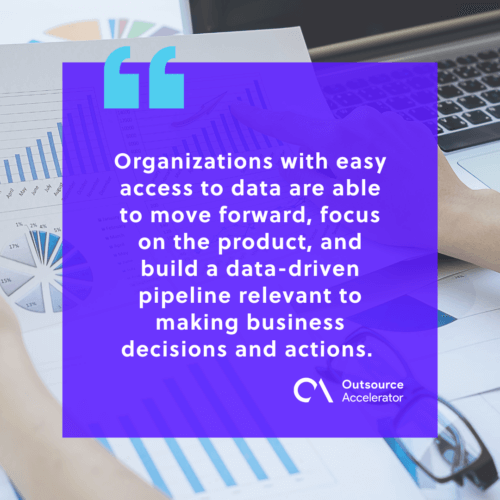Data accessibility: What is it, and why is it important to organizations?

Data is the heart of every business. It serves as a primary resource for business. Maximizing business potential greatly depends on how much data can be accessed and utilized to improve daily operations.
NVP’s 2021 survey states that almost 99% of organizations are investing in data. However, data accessibility at every level in any organization can pose a challenge. There are instances of error and inefficiencies which might impact the business performance.
While data[1] seem readily available, it doesn’t mean they are usable enough for people with little experience handling data. Thus, many businesses find ways to break through data accessibility issues to leverage its key value.
This article will discuss data accessibility[2] and outline the common ways businesses need to improve their data accessibility.

Defining data accessibility
Simply put, data accessibility is the ability of people in an organization to access data from databases and leverage it to its fullest extent. These data will significantly help organizations foster productivity and bring value to businesses.
With data accessibility, users have the ability to copy, move, modify or retrieve data from IT systems from any location in an authenticated manner.
Why data accessibility matters
Data access is crucial for any business and is an integral part of growing an enterprise. Thus, the increasing expansion of technologies is equivalent to the increasing availability of data sources.
Some companies fail to relate data investment to business insights and results. According to the report conducted by Forrester, 74% of organizations want to be data-driven, yet only 29% say they are good at linking analytics to business actions.
Organizations with easy access to data are able to move forward, focus on the product, and build a data-driven pipeline relevant to making business decisions and actions.

How to improve data accessibility?
Here’s the breakdown of how organizations can improve their data accessibility.
Identify what your business needs
First, identify and understand what the organization needs to suffice.
To have a good data management strategy, knowing the business goals and objectives is very important. These will determine the information and insights needed to meet those goals.
Create effective data processes
After identifying the objectives, businesses need to take action. Creating effective data processes is what comes next in improving data accessibility. These processes include:
- Collection. It involves identifying sources, data to be accessed, use of a structure or unstructured data, and how the data will be collected, whether it is manually or not.
- Preparation. This is a preparation for analysis. It involves determining data that is incomplete or disparate and putting data in a system in place.
- Data analysis. Separate on allowing users to access and analyze data and how they will communicate insights.
- Data storage. It deals with how organizations keep data and how it will be secure while it is not used.
Lean on the self-service business intelligence tool
Another way to improve data accessibility is to utilize the self-service business intelligence tool. It allows users to build a dashboard and perform data analysis of those data for themselves, regardless of the level of their expertise.
With the use of the self-service BI tool, it prioritizes the ease of use for business users. In turn, it can help businesses make data-driven decisions and thrive.
Embed dashboards into your team’s tools
Embedded dashboards are great for improving data accessibility as they will significantly help businesses to add visualizations about data and analytics. It improves user experience since it has a visual interface and it adds an interactive element.
When embedding dashboards in your team’s tool, users are easily able to find the right information they need to make data-driven decisions without leaving that particular tool.
Data governance
Having strong data governance is crucial to any organization as this ensures that the data is private, accurate, consistent, available, and usable for users.
It is important to have a single source of truth for all businesses at every level. Since the data will be placed in one data warehouse, it ensures consistency in decision-making and stronger data security.
Promote data literacy
If all employees are data literate, it is easy to achieve and improve data accessibility in an organization.
Data literacy means teams and departments can accurately interpret and effectively use the same data they all share in making tough decisions.
Training and execution
Not all employees have the same level of expertise when working on data. Thus, it is essential for businesses to train employees on how they will value data, its importance, and how they will gain business insights from it.
Training employees on using tools and technologies is also crucial to working with data without difficulty.
Ensure data accessibility across your organization
In today’s digital world, the influx of available data presents both an opportunity to thrive in business as well as a challenge to overcome.
Thus, establishing a data-informed culture within your organization is crucial. This should be a priority for all businesses to improve data accessibility.
Providing employees with the right tools to achieve data accessibility will fuel fact-based and data-driven business decisions. Everyone in the organization should understand the capabilities of the data linked to business insights.
Article References:
[2] Data accessibility. Göpferich, S. (2010). Data Documentation and Data Accessibility in Translation Process Research. The Translator, 16(1), pp.93–124.







 Independent
Independent




